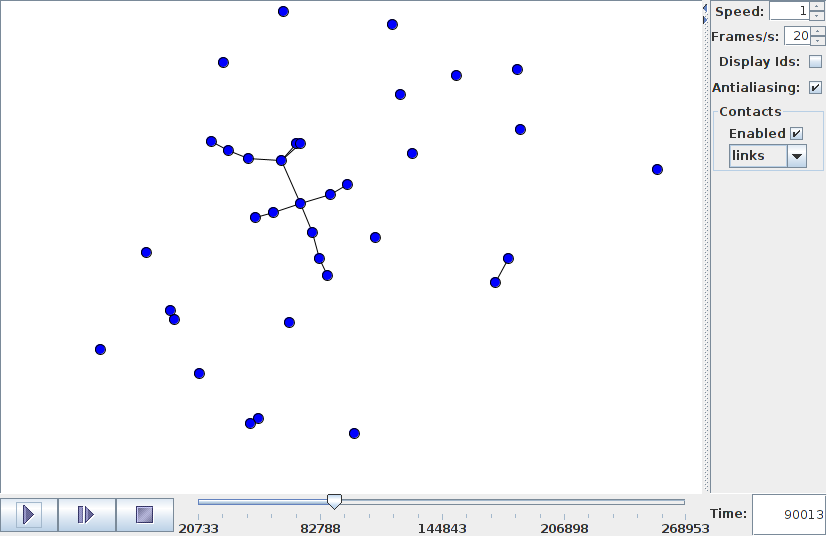Introduction
This page contains visualizations of real-life contact traces that we use for our research on dynamic graphs and opportunistic networking. They aim at conveying an intuituive feeling for connectivity in these traces that goes beyond stat-crunching. We have also found them useful for investigating outliers or suprising routing events. We are making them public in hopes that others will find them equally useful. The animations are based on our work on plausible mobility [WHI10]. We will be progressively adding new animations as needed. If however you will like us to animate a specific trace, please send your request to john.whitbeck@lip6.fr.
Each visualization may be played directly from this page (requires Java Web Start which should be bundled with all Java installations). Use the mouse's scroll button to zoom in and out; click-and-drag to move within the player's window. Alternatively, a tarball containing the original data and the code to rebuild the visualization is available for download.
The source code is publicly available. It is still a little rough around the edges and currently lacks documentation but we will improve that in the coming months.
Datasets
Rollernet [TOU10]
Opportunistic sighting of Bluetooth devices by groups of rollerbladers carrying iMotes in a roller tour in Paris, France, on August 20, 2006. The iMotes iniated neighborhood scans every 15 seconds.
The iMotes were distributed to three types of skaters: staff, members of the skating association, and friends of the experimenters. Nodes 27 and 38 were at all times at the front and back, respectively, of the rollerblading tour. Furthermore, the inferred mobility was constrained within a thin rectangular area to simulate movement along a road. All times are relative to the first unix timestamp in the raw trace.
- Play (2.8MB). The first 1000 seconds are rather static so feel free to skip them.
- Download original trace from Crawdad.
Infocom'05 [CHA07]
Bluetooth sightings of 41 users carrying small Bluetooth devices (iMotes) for four days (March 7-10, 2005) in the Grand Hyatt Miami during the INFOCOM 2005 conference. The iMotes iniated neighborhood scans every 2 minutes.
- Play (2.5MB).
- Download original trace from Crawdad.
Infocom'06 [CHA07]
Bluetooth sightings of 70 users carrying small Bluetooth devices (iMotes) for four to five days (April 23-27, 2006) in the Princesa Sofia Grand Hotel, Barcelona, during the INFOCOM 2006 conference. The iMotes iniated neighborhood scans every 2 minutes.
iMotes 1-20 are static long-range (~100m) motes that were deployed within the conference area. The deployment map is included in the data on Crawdad . The conference area spanned 3 different levels (mezzanine, floor -1, and floor -2). In the inferred mobility, static motes were placed according to two rules: (i) motes on the same floor keep the same relative placement as on the deployment map, and (ii) motes from different floors that could detect each other were placed close to each other.
- Play (7MB).
- Download original trace from Crawdad.
PMTR [GAI09]
This dataset contains mobility traces from 44 custom made Pocket Mobile Trace Recorders (PMTRs) at University of Milano. The PMTRs were distributed to faculty members, PhD students, and technical staff. Beacons were sent every second. These people work in offices and laboratories located in a three-floor building, roughly 200x100 m large and take lunches or coffee breaks in a nearby cafeteria. The data was collected during 10 days in November 2008.
- Play (10.9MB).
- Download original trace from Crawdad.
Stanford High School [SAL10]
Face-to-face contacts among all people in a US high school captured by ZigBee motes (TelosB Crossbow) between 7AM and 4PM. Beacons were sent every 20 seconds. The 789 participants were divided into four groups: student, teacher, staff, and other.
- Play (32.9MB).
- Download original trace from the Salathe Group's page.
Source code
The plausible mobility code is available at github. It is built on top the DiTL library (a generic library for handling and combining a variety of time-indexed stateful event traces). The plausible mobility code is found under the ditl/plausible directory. Instructions for downloading an rebuilding all the inferred mobilities on this page are available in the examples directory.
References
-
From Encounters to Plausible Mobility



John Whitbeck, Marcelo Dias de Amorim, Vania Conan, Mostafa Ammar, Ellen Zegura
Pervasive and Mobile Computing - Vol. 7, Issue 3 (April 2011), pages 206-222 -
Plausible Mobility: Inferring Movement from Contacts



John Whitbeck, Marcelo Dias de Amorim, Vania Conan
ACM Workshop on Mobile Opportunistic Networking (MobiOpp 2010) - Pisa, Italy - February 2010
-
Density-Aware Routing in Highly Dynamic DTNs: the RollerNet Case

Pierre Ugo Tournoux, Jeremie Leguay, Farid Benbadis, Vania Conan, Marcelo Dias de Amorim, John Whitbeck
IEEE Transactions on Mobile Computing (to appear) -
Impact of Human Mobility on Opportunistic Forwarding Algorithms
Augustin Chaintreau, Pan Hui, Jon Crowcroft, Christophe Diot, Richard Gass, and James Scott
IEEE Transactions on Mobile Computing, Volume 6, Issue 6 (June 2007) -
Opportunistic Forwarding in Workplaces
Sabrina Gaito, Elena Pagani, and Gian Paolo Rossi
Proc. 2nd ACM SIGCOMM Workshop on Online Social Networks (WOSN 2009) - Barcelona, Spain, August 2009
-
A High-Resolution Human Contact Network for Infectious Disease Transmission
Marcel Salathé, Maria Kazandjieva, Jung Woo Lee, Philip Levis, Marcus W. Feldman, and James H. Jones
Proc. National Academy of Sciences, Volume 107, Issue 5 (December 21, 2010)




